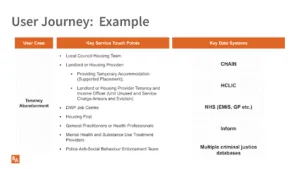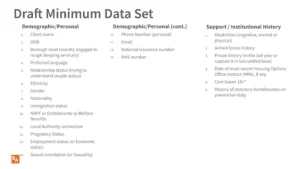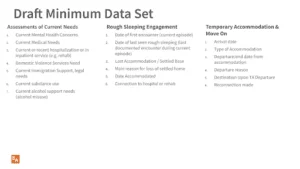Understanding Rough Sleeping in London
LOTI is working with London Councils, the Greater London Authority and Bloomberg Associates to design and deliver a data tool that supports the strategic aims of London’s Life off the Streets programme (LOTS). The key aim of LOTS is to help make rough sleeping rare, brief and non-recurrent in London.
Background
Strategic decision makers currently lack the data to understand the pathways into and out of rough sleeping. The lack of data hinders the development of preventative approaches. Blind spots include the circumstances and institutions that people are in immediately prior to entering rough sleeping, and the medium and long term outcomes for those who are provided with services such as hostels or temporary accommodation. For example, by analysing how people move through the rough sleeping ecosystem, we can begin to build a picture of how many people are likely to re-enter rough sleeping after leaving short-term accommodation or the probation service and what their specific circumstances and needs are. This provides the required insights to design targeted services that can be deployed to the right people at the right time to prevent rough sleeping.
Discovery
We used the LOTI Data Projects Methodology to guide our project design and discovery. We started by taking the outcomes defined by the Life of the Streets programme as our goal and working backwards to determine the type of solution and data that might be suitable for helping us to meet the goal of making rough sleeping, rare, brief and non-recurrent.
We conducted a user journey mapping exercise that involved London Councils engaging with rough sleeping leads and practitioners from across the boroughs to examine the pathways of people accessing rough sleeping, homelessness and related services across London. The result of the work was to produce journeys for a number of common personas including which services they touched and the data systems they would be recorded in. This allowed us to identify the core systems that should contribute to our insights tool. Our initial tool will include data from the Combined Homelessness and Information Network (CHAIN), data from hostel providers stored in Inform, and data held in borough Homelessness Case Level Collection (H-CLIC) returns.

The research phase saw further engagement with rough sleeping practitioners across the ecosystem through workshops and one on one interviews. This helped us to understand the key operational and strategic challenges across London and develop a draft minimum data set of indicators that could be used to help address these challenges.
Bloomberg Associates have been leading the work to curate the minimum data set which has included an exploration of the data fields and how they are coded across CHAIN, Inform powered systems and HCLIC returns. This work has enabled us to see the similarities and differences in how fields are defined and recorded, exposing interesting challenges around fields with a temporal element such as pregnancy status and where support needs are recorded in more general qualitative fields versus coded.


As we moved towards specifying a product, we focused on the use cases that would deliver the most value to those commissioning rough sleeping services in London. We conducted further workshops to refine a long list of user stories down to a prioritised list that will help form our initial development backlog. One of the use cases will be to support reporting on the new Department for Levelling Up Housing and Communities (DLUHC) rough sleeping KPIs that all local authorities will need to report on in the future.
What happens next
Having completed an initial discovery, our intention is to create a tool that ingests and presents data in a way that enables strategic decision makers working on tackling rough sleeping in London to have deeper insights into the pathways into rough sleeping and the effectiveness of various interventions. We have secured funding for the work from London Borough Housing Directors and will be procuring support to help us design and build the solution.
A Minimum Viable Product (MVP) will be delivered in July 2023, that will include data from CHAIN and 4 pilot boroughs and their hostel provider. The Pilot boroughs are Camden, Lambeth, Hillingdon and Westminster. If the MVP is successful we will work to onboard the remaining boroughs through the rest of the year.
Information Governance
The project will link individual records but the outputs will be anonymised and aggregated for the strategic use case we have identified. We are working with Information Governance leads from across the boroughs and hostel providers and following the Information Governance for London (IGfL) Working Group approach to ensure data is shared responsibly and legally.
The future
Our collective ambition goes way beyond the scope of our initial MVP, we would like to see more datasets added to the system to build a more complete understanding of rough sleeping in London as part of our ambition to make rough sleeping, rare, brief and non-recurrent. These could include data from the Probation Service, health and care data and eviction data.
Once the system is live there is also an opportunity to build a data science capability that can perform more sophisticated analysis. We are excited by the prospect of working with borough data scientists and analysts alongside expertise from research institutions, such as the Alan Turing Institute.
For now, we need to stay focused on delivering our MVP and proving the value of this collaborative project that will see many diverse stakeholders come together to tackle one of London’s big challenges.
The main objectives of creating this data tool are to:
- Measure success in making homelessness rare, brief, non-recurrent
- Improve understanding of the rough sleeping population (including the complexity of needs and how individuals move between different parts of the system)
- Improve understanding of individual outcomes for rough sleepers (anonymised)
- Learn what strategies work and inform public policy, service delivery and commissioning
- Enhance the effective operation of services for those who are rough sleeping
- Ease and enhance reporting and performance management
Visit the rough sleeping insights project page to stay updated on the latest developments.
Jay Saggar

